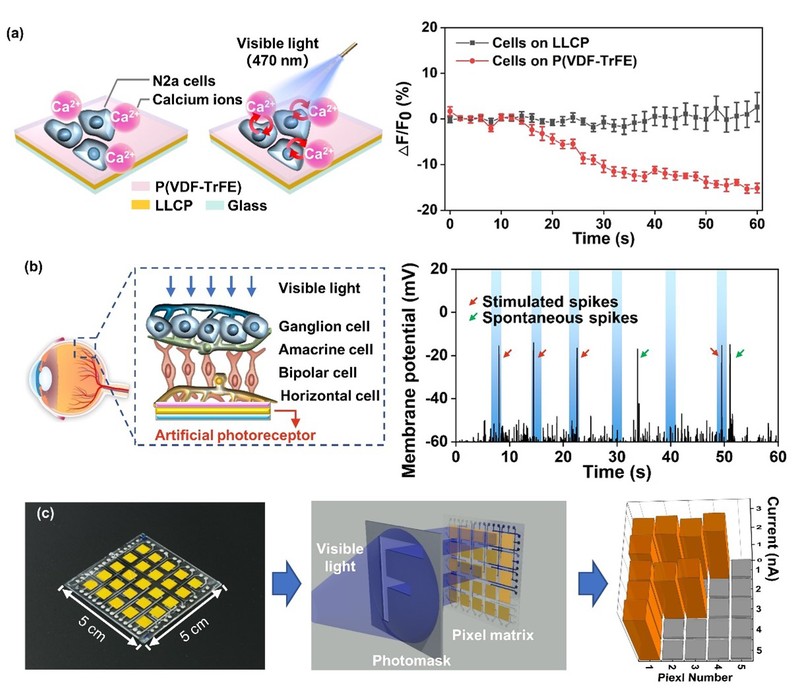Search
Title: A Neuron-Readable Artificial Photoreceptor Composed of Photodeformable Liquid Crystal Polymers and Piezoelectric Materials
Author: Bo Peng, Xueli Chen, Guodong Yu, Fan Xu, Ruyi Yang, Zhenghang Yu, Jia Wei, Guodong Zhu, Lang Qin, Jiayi Zhang, Qundong Shen, Yanlei Yu*
Journal: Adv. Funct. Mater., 2023, 33(23), 2214172
Abstract:
Artificial photoreceptors are extensively developed to help the patients with serious eye diseases by converting light into electric signals. However, the existing systems still suffer from poor output signals, restricting signal transduction to cells. Here, a neuron-readable artificial photoreceptor with significant voltage output is constructed by using photodeformable liquid crystal polymers (LCPs) and polyvinylidene fluoride trifluoroethylene (P(VDF-TrFE)). The significant voltage output originates from light-stress-electricity conversion, where the photo-induced stress is attributed to the free volume expansion of the photodeformable LCPs and subsequently converts them into strong electric signals by the P(VDF-TrFE) layer. The photo-induced open-circuit voltage reaches up to 0.79 ± 0.02 V, which is, to the knowledge, 19 times higher than the maximum voltage (0.04 V) that has been reported to date. Hence, such artificial photoreceptor successfully transduces photo-induced electric signals to cells and tissues, communicates with the neurons, and triggers spiking activities in blind retinas. Besides, visual image recognition is demonstrated in a pixelated matrix by analyzing electric signals of each unit. This artificial photoreceptor opens new opportunities for the combination of the photodeformability and piezoelectricity, providing an avenue to develop neuron-readable artificial retinas and implantable sensors.
Fulltext Link: https://onlinelibrary.wiley.com/doi/10.1002/adfm.202214172
Article Express:
Impaired or missing vision, which is an important way for humans to obtain information, will bring many inconveniences to life. Due to the lack of effective therapies, the treatment of blindness has always been a worldwide problem. Artificial photoreceptors can replace natural receptor cells to convert light signals into electrical signals, providing a new solution for treatment. However, the poor photoelectric signals of current artificial photoreceptors will limit the signal transmission to cells.
To enhance the photoelectric signals, Prof. Yu and coworkers, from the Department of Materials Science in Fudan University, reported an artificial photoreceptor constructed by photodeformable liquid crystal polymers and piezoelectric materials with an open-circuit voltage of 0.79 ± 0.02 V under illumination through light-stress-electricity conversion, which is 19 times higher than the maximum voltage (0.04 V) that has been reported to date. This artificial photoreceptor contains of four layers on a glass substrate, including the photodeformable layer, the piezoelectric layer and two conductive electrodes (Figure 1a). The azobenzene moieties undergo both trans-cis-trans isomerization under the illumination of 470 nm, leading to free volume expansion and generating photo-induced stress, which is key to improve the output electrical signals in artificial photoreceptors. Under the illumination of 470-nm light, the photo-induced stress generated in the LLCP layer is transferred to the P(VDF-TrFE) layer, where the density change of dipoles leads to the charge redistribution between the two electrodes and the output of the electric signals (Figure 1c).

Figure 1. (a) Schematic illustration to show the multi-layer structure and composition of the artificial photoreceptor, including linear liquid crystal polymer (LLCP) and polyvinylidene fluoride trifluoroethylene (P(VDF-TrFE)). (b) Lateral view photograph of the LLCP film deformation and the mechanism under the illumination of 470-nm light. (c) Plot showing the open-circuit voltage of the artificial photoreceptor during ten cycles.
Thanks to the excellent electric signal output, the artificial photoreceptor exhibits the messenger exchange process among neuron cells, retinal tissues and the environment under the stimuli of the artificial photoreceptor. Calcium-ion imaging showes that the calcium-ion concentrations of cells on the P(VDF-TrFE) layer decrease, which indicates that the balance of cytosolic calcium concentration is broken between the calcium influx and efflux (Figure 2a). The artificial photoreceptor is further interfaced with retinal degenerated blind mouse retinas. It is clear that the retinal ganglion cells responses are closely correlated with the light stimulation, indicating the transduction in blind retinal tissues.
The above results indicate that photoelectric signals are successfully transmitted to neurons and retinal tissues and cause effective stimulation (Figure 2b). This process is very similar to the light-electricity conversion in human’s retina, showing potential in constructing artificial visual system. Human’s eyes contain 100 ~ 120 million photoreceptors, which jointly undertake visual imaging function. Inspired by this, researchers integrated multiple artificial photoreceptors into a 5×5 pixelated matrix, where each artificial photoreceptor is one pixel. The values in the illuminated pixel units are 21 times higher than those in blocked units, which lays the foundation for the accuracy of the visual image recognition. The values of short-circuit current are measured by histogram in Figure 2c to display the image and the clear “F” and “9” patterns are obtained. This study will facilitate the development of future investigations on implantable devices of the LCPs, and open up new vistas for neuron-readable artificial retinas as well as intelligent detectors.

Figure 2. (a) Signal transduction from the artificial photoreceptor to the neurons. (b) Light responses of retinal ganglion cells in the blind retina with the artificial photoreceptor. (c) The photograph of the pixelated matrix and pattern recognition.
The relevant research results were promoted by the WeChat Official Account 'Frontiers of Polymer Science', 'Polymer Technology' and 'BioMed Technology'.
Official Accounts link:
https://mp.weixin.qq.com/s/4KJse5mZ3ohkILbffWCz2A (Frontiers of Polymer Science)
https://mp.weixin.qq.com/s/W8Khv-U8uuEXcK7o-6wYNw (Polymer Technology)
https://mp.weixin.qq.com/s/cOFGqb5gcb61nKBSAG5g8Q (BioMed Technology)







